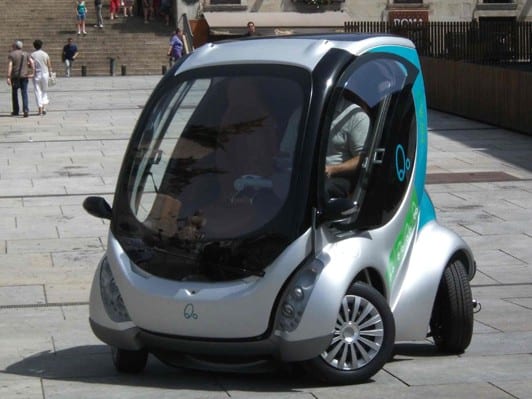
SALES of electric cars in Andalucia are up a whopping 35%, but the number was only a modest 84 units.
So the increase in green-powered vehicles means motorists are unlikely to be stuck behind one in traffic.
Overall sales in Spain hit 698, up 29.02% on the same period last year.
Hybrid car sales grew by 56.5% to 2,138 in Andalucia, with a rise of 29.02% to 13,328 across Spain.









Great for the flat in city centres, but Andalucía has hills and mountains. Lots of hills and mountains.
This is great news, though the latest monthly figures for October 2015 from Madrid show an increase of over 300% over same period last year, and 150% year-to-october – so come on Andalucia.
The main problem really is the deplorable state of charging infrastructure in Spain generally, outside of Madrid and Barcelona. Currently, Spain has roughly 1/3rd the number of Chademo rapid chargers in the UK, despite the autovia/autopista network (and the country in general) being much larger. CCS rapid chargers in Spain are effectively non-existent. In the last few months, the central government has relaxed regulations that made installation of chargers difficult, so we can only wait and see if this will help speed up the roll-out of a decent network that will allow for easy inter-city travel. Until then, electric cars will be the preserve of those wealthy enough to have two cars, or who only rarely drive far from home. This is NOT a problem with electric cars, but rather with the government’s blindspot when it comes to matching one policy (very generous incentives) with the other (infrastructure spending/planning rules for charging).
The sad thing is that when it comes to clean transport, if the central gov’t invested 1% of the money it’s put into the AVE into deploying rapid chargers and revamping the EV incentive system, Spain would have one of the best environments for electric cars on the planet – whilst still having more than enough for a very good AVE network focused on routes that would actually be viable.
@Fred EV range isn’t as badly affected as people assume if correct driving practice is used. Modern EVs have far more advanced re-generative braking than earlier designs, so can recover much of the energy consumed on the climb when it comes to the decent. Also, more cars are being released with greater range, making un-recovered loss on hills less important.
Electrically-driven cars are certainly the future, but battery-technology is struggling. Therefore hydrogen, generating electricity, within the vehicle is likely to be the means of propulsion. Charging stations have many problems, not least the cost of a nation-wide roll-out. Hydrogen just needs a tank and a pump, very much in the way large parts of Spain are supplied with calor gas.
Hydrogen, the most abundant fuel in the universe is completely pollution free, the technology to produce it is simple. The only thing missing is the will go for it in the face of the immense power of the oil-men.
Around town these cars are fine. Inland, forget it. You don’t need any expertise in this industry to know that. The state of the roads is enough to scupper this.
EV cars are mostly the same models as ICE ones. I don’t see why poor roads come into it. If anything electrics tend to do better on imperfect roads as there’s maximum torque from 0 to max RPM, fewer moving parts, no big air intakes and more even weight distribution.
And to be brutally honest, demographics rule at the end of the day. Most people don’t live in small inland villages, and manufacturers want to sell cars to most people, not everyone. There are going to be holdouts, either by choice or necessity just like people using typewriters – and doubtless there will be people willing to part them of their money with a niche product like custom-REX units, or conversions of legacy vehicles that fill small but specific niches (like the Lada Niva, for example)
Actually, oil companies have been the promoters of hydrogen technology, precisely because it can be produced from natural gas, so it doesn’t cut into the fossil fuel market. Hydrogen can be produced from water, but doing that requires a massive amount of infrastructure – whilst any form of hydrogen will require a massive distribution infrastructure equivalent (but different) to what exists for petrol/diesel. Storage wise, Hydrogen needs to be stored at very high pressure (690 bar) so it’s very expensive to do.
This is why hydrogen infrastructure is far behind charging stations. A typical rapid charger installation costs around €35-€50k in a totally undeveloped site, and a fraction of that in a site with an adequate power supply and hardstanding already in place. By contrast a hydrogen installation of high pressure subterranean storage, cut-offs, distro pumps and safe venting systems typically costs from €500k up to €1m+. At the end of the day a rapid charger is basically just a phone charger turned up to 11. There’s no advanced or costly technology involved, and there’s no moving parts. Distribution is done entirely by the existing power grid (it’s just an inverter and socket adapter)
The other thing is investment. Battery technology benefits from being used in *everything* from cars to phones to vacuum cleaners. Tesla cars were made possible by battery companies carrying out research to make laptop batteries. Economies of scale and shared manufacturing is bringing down battery costs rapidly. In 2010 the Citroen C-zero used an 18kw/h li-ion that took up 2/3rds of the car cost, which was around €30k. Now, Nissan sells the Leaf with 30kw/h batteries for a price just below that of the old C-zero, whilst the C-Zero is sold for less than half what it was. Hydrogen cars aren’t yet where battery was in 2010, and they probably can’t catch up, because even if Nissan and Tesla stood still, Apple, Samsung, Lenovo, Panasonic, LG and everyone else will still mean existing Li-ion technology becomes cheaper, smaller and more energy dense, whereas hardly anyone has a stake in making fuel cells (the oil companies only want to sell the hydrogen, not build the cars).
Up until now cars have been able to escape the convergence and commodification of consumer electronics, but that is changing and only those manufacturers that realise that partner with electronics companies now (as some have) and figure out new business models (BEVs dont need any high level servicing)are going to tough it out in the long term. You can go out right now and buy an battery-electric car with 500km range, and can charge to 80% of capacity in 30 minutes. The battery technology really isn’t the problem, it’s our governments struggling to overcome not only entrenched interests, but entrenched practices and thinking.
The Nissan Leaf was the first car I looked at after reading your reply and the main issues faced (battery life) were road conditions and driving style. Common sense – we dont need reams of technical data to know that TumblingGoat. At least we agree that the metropolis is where these cars have a future.
T/G,
thanks for your input, I for one loves technical info, it helps me to make rational choices. Stefanjo, you could’nt be more wrong about batteries, they are evolving at a rate of knots, just wait until graphene ones appear. They will revolutionise so many industries.
Fred, I would’nt have expected your last post. The city maybe the place for e/cs now but this will change within a few years. The Japanese have built an e/c that is an effective sports car with a long range but then you would expect that from the Japanese.
Stuart, I have friends who work in the electric car industry (in Spain) and this is what they tell me the challenges are. Btw, I wasn’t commenting about the cars of the future, I was commenting about the state-of-play at the moment and near-future. I’d love to see electric cars in use all over Andalucia, indeed everywhere, but will it be practical.
“You can go out right now and buy an battery-electric car with 500km range”
Sure, but that range depends on road conditions, driving style, weather conditions, gradients etc, so you won’t get exactly 500 km. Running out of batterty on the motorway or up a mountain pass will be a common problem.
You can’t run out of hydrogen if you keep your eye on the gauge. Check how the state-of-the-art, £350.000, Battery driven, “Boris Buses” are faring in London (which is pretty flat)